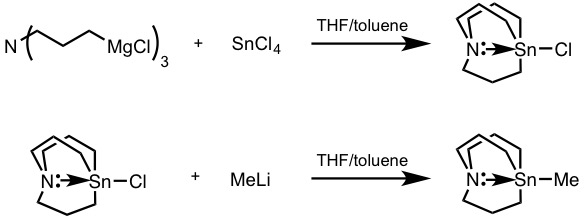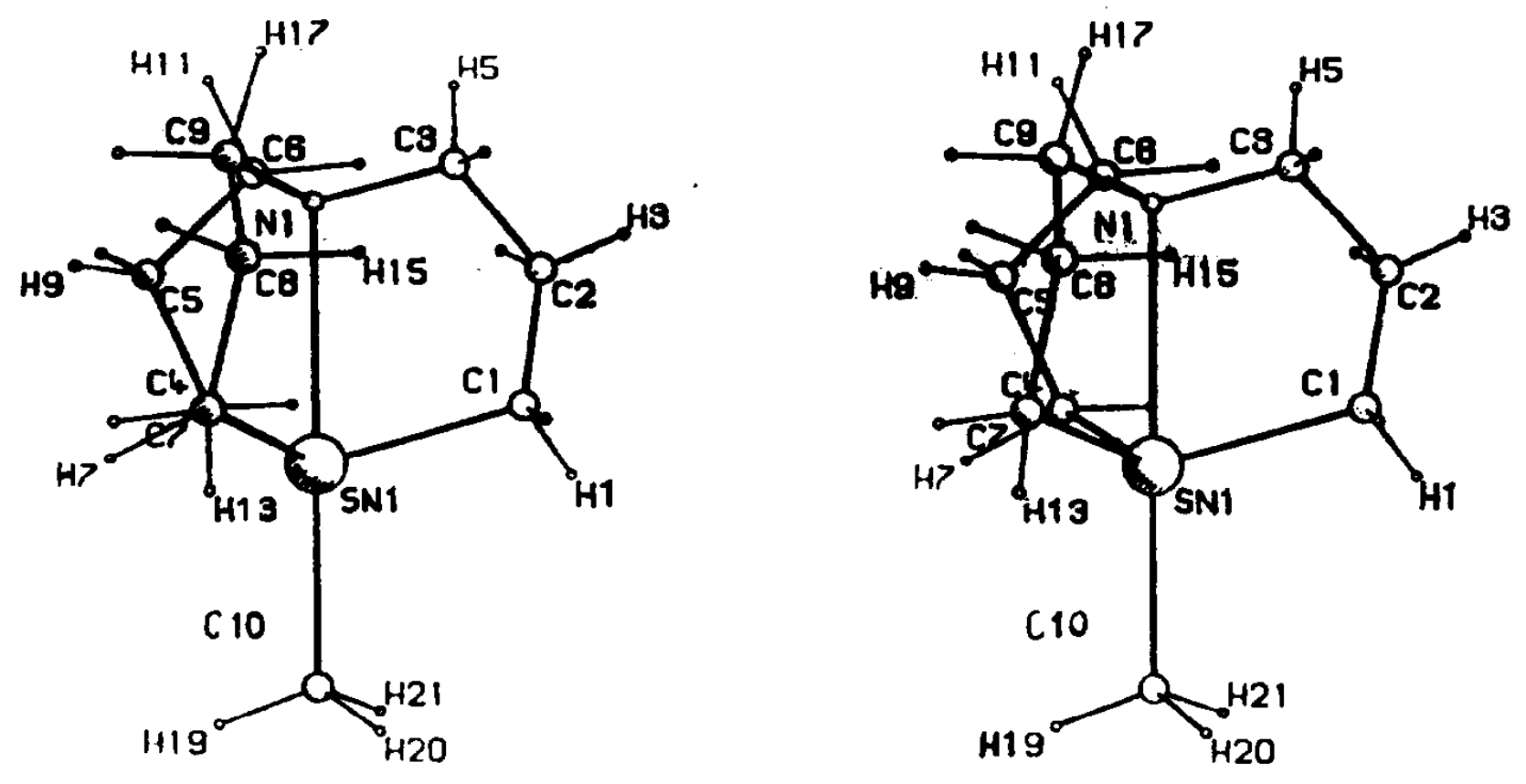Stannatrane on:
[Wikipedia]
[Google]
[Amazon]
 A stannatrane (IUPAC: 1-aza-5-stannabicyclo .3.3ndecane) is a
A stannatrane (IUPAC: 1-aza-5-stannabicyclo .3.3ndecane) is a

 The crystal and molecular structure was explained by
The crystal and molecular structure was explained by
 Though the latter step is still commonly used for functionalization of stannatrane chloride to simple alkyl derivatives ''via'' transmetalation, Biscoe and coworkers have developed a lithiation method that provides access to a variety of enantioenriched alkyl substituents from optically active mesylates (2). After treatment of stannatrane chloride with lithium napthalide, a lithium carbastannatrane was quenched with the corresponding enantiopure mesylate to yield the desired enantioenriched alkyl carbastannatrane in moderate yield with high
Though the latter step is still commonly used for functionalization of stannatrane chloride to simple alkyl derivatives ''via'' transmetalation, Biscoe and coworkers have developed a lithiation method that provides access to a variety of enantioenriched alkyl substituents from optically active mesylates (2). After treatment of stannatrane chloride with lithium napthalide, a lithium carbastannatrane was quenched with the corresponding enantiopure mesylate to yield the desired enantioenriched alkyl carbastannatrane in moderate yield with high

 A stannatrane (IUPAC: 1-aza-5-stannabicyclo .3.3ndecane) is a
A stannatrane (IUPAC: 1-aza-5-stannabicyclo .3.3ndecane) is a tin
Tin is a chemical element with the symbol Sn (from la, stannum) and atomic number 50. Tin is a silvery-coloured metal.
Tin is soft enough to be cut with little force and a bar of tin can be bent by hand with little effort. When bent, t ...
-based atrane
Atranes are a class of tricyclic molecules with three five-membered rings. It is a heterocyclic structure similar to the propellanes. It has a transannular dative bond from a nitrogen at one bridgehead to a Lewis acidic atom such as silicon or bor ...
belonging to the larger class of organostannanes. Though the term stannatrane is often used to refer to the more commonly employed carbastannatrane, azastannatranes have also been synthesized (prefix refers to the identity of the atom
Every atom is composed of a nucleus and one or more electrons bound to the nucleus. The nucleus is made of one or more protons and a number of neutrons. Only the most common variety of hydrogen has no neutrons.
Every solid, liquid, gas, ...
bound directly to tin center). Stannatrane reagents offer highly selective methods for the incorporation of "R" substituents
A substituent is one or a group of atoms that replaces (one or more) atoms, thereby becoming a moiety in the resultant (new) molecule. (In organic chemistry and biochemistry, the terms ''substituent'' and ''functional group'', as well as ''side ...
in complex molecules for late-stage diversification. These reagents differ from their tetraalkyl organostannane analogues in that there is no participation of dummy ligands in the transmetalation step, offering selective alkyl transfer in Stille Coupling
The Stille reaction is a chemical reaction widely used in organic synthesis. The reaction involves the coupling of two organic groups, one of which is carried as an organotin compound (also known as organostannanes). A variety of organic electroph ...
reactions. These transmetalating agents are known to be air- and moisture-stable, as well as generally less toxic than their tetraalkyl counterparts.
History and structural properties
The first carbastannatrane was reported in 1984 by Jurkschat and Tzschach. By reaction of an amino-tri Grignard reagent withtin(IV) chloride
Tin(IV) chloride, also known as tin tetrachloride or stannic chloride, is an inorganic compound with the formula Sn Cl4. It is a colorless hygroscopic liquid, which fumes on contact with air. It is used as a precursor to other tin compounds. It w ...
to yield the stannatrane chloride, which was treated with methyl lithium
Methyllithium is the simplest organolithium reagent with the empirical formula CH3Li. This s-block organometallic compound adopts an oligomeric structure both in solution and in the solid state. This highly reactive compound, invariably used in s ...
to yield the corresponding methyl stannatrane. Based on a very small methyl ''J''(119Sn–13C) coupling constant of 171 Hz, it was determined that the tin center of methyl stannatrane was indeed pentacoordinate, indicating nitrogen coordination.

 The crystal and molecular structure was explained by
The crystal and molecular structure was explained by X-ray crystallography
X-ray crystallography is the experimental science determining the atomic and molecular structure of a crystal, in which the crystalline structure causes a beam of incident X-rays to diffract into many specific directions. By measuring the angles ...
. The X-ray diffraction study confirmed the tricyclic ring structure and gave insight toward the geometry of the complex. With a tin-nitrogen distance of 2.624 Å, the formal bond order was calculated to be about 0.46. The presence of the tin-nitrogen interaction, albeit weaker than anticipated, led to a few key discoveries: (1) the distortion from ideal trigonal bipyramidal
In chemistry, a trigonal bipyramid formation is a molecular geometry with one atom at the center and 5 more atoms at the corners of a triangular bipyramid. This is one geometry for which the bond angles surrounding the central atom are not ident ...
toward monocapped tetrahedron geometry; (2) the lengthening of the apical tin-methyl bond by ~ 0.1 Å (largest known value for any existing tetraorganotin compounds); (3) the observation of unusual hybridization at the apical tin-methyl bond.
Syntheses of alkyl stannatranes
A modified synthesis of atrane tricycle utilizesSchwartz's Reagent
Schwartz's reagent is the common name for the organozirconium compound with the formula (C5H5)2ZrHCl, sometimes called zirconocene hydrochloride or zirconocene chloride hydride, and is named after Jeffrey Schwartz, a chemistry professor at Prince ...
, triallylamine
Triallylamine is the organic compound with the formula N(CH2CH=CH2)3. It is a colorless liquid with an ammonia-like odor. It is multifunctional, featuring a tertiary amine and three alkene groups. Triallylamine (and mono- and diallyl amines) is p ...
, and tin(IV) chloride in a one-pot method.
 Though the latter step is still commonly used for functionalization of stannatrane chloride to simple alkyl derivatives ''via'' transmetalation, Biscoe and coworkers have developed a lithiation method that provides access to a variety of enantioenriched alkyl substituents from optically active mesylates (2). After treatment of stannatrane chloride with lithium napthalide, a lithium carbastannatrane was quenched with the corresponding enantiopure mesylate to yield the desired enantioenriched alkyl carbastannatrane in moderate yield with high
Though the latter step is still commonly used for functionalization of stannatrane chloride to simple alkyl derivatives ''via'' transmetalation, Biscoe and coworkers have developed a lithiation method that provides access to a variety of enantioenriched alkyl substituents from optically active mesylates (2). After treatment of stannatrane chloride with lithium napthalide, a lithium carbastannatrane was quenched with the corresponding enantiopure mesylate to yield the desired enantioenriched alkyl carbastannatrane in moderate yield with high enantiomeric excess
In stereochemistry, enantiomeric excess (ee) is a measurement of purity used for chiral substances. It reflects the degree to which a sample contains one enantiomer in greater amounts than the other. A racemic mixture has an ee of 0%, while a si ...
.
Applications in cross-coupling
The earliest reported use of carbastannatranes in palladium-catalyzed Stille coupling reactions in 1992 compared the efficiency of methyl stannatrane with tetramethyltin in the presence of aryl bromides and alkenyl iodides. Tetramethyltin only resulted in less than five percent conversion, whereas methyl stannatrane resulted in 67% yield under the same conditions. This difference was attributed to the nitrogen lone pair lengthening the tin-methyl bond, increasing its lability toward transmetalation. A method was developed for Stille couplings of aziridinyl stannatranes with arylelectrophile
In chemistry, an electrophile is a chemical species that forms bonds with nucleophiles by accepting an electron pair. Because electrophiles accept electrons, they are Lewis acids. Most electrophiles are positively charged, have an atom that carrie ...
s.

Palladium
Palladium is a chemical element with the symbol Pd and atomic number 46. It is a rare and lustrous silvery-white metal discovered in 1803 by the English chemist William Hyde Wollaston. He named it after the asteroid Pallas, which was itself na ...
also catalyzes Stille coupling of secondary alkyl carbastannatranes and aryl electrophiles. This report serves as the first example of employing chiral
Chirality is a property of asymmetry important in several branches of science. The word ''chirality'' is derived from the Greek (''kheir''), "hand", a familiar chiral object.
An object or a system is ''chiral'' if it is distinguishable from i ...
alkyl carbastannatrane reagents in enantioselective synthesis. Related methodology enable selective acyl substitution using enantioenriched stannatranes as an alternative to classical enolate
In organic chemistry, enolates are organic anions derived from the deprotonation of carbonyl () compounds. Rarely isolated, they are widely used as reagents in the synthesis of organic compounds.
Bonding and structure
Enolate anions are electr ...
chemistry.
A stannatrane-mediated Stille coupling was utilized for the synthesis of an anti- methicillin-resistant carbapenem
Carbapenems are a class of very effective antibiotic agents most commonly used for the treatment of severe bacterial infections. This class of antibiotics is usually reserved for known or suspected multidrug-resistant (MDR) bacterial infections. ...
to incorporate an entire side-chain in a single step.
References
{{Reflist, 30em Organotin compounds Heterocyclic compounds with 3 rings Tin(IV) compounds Atranes